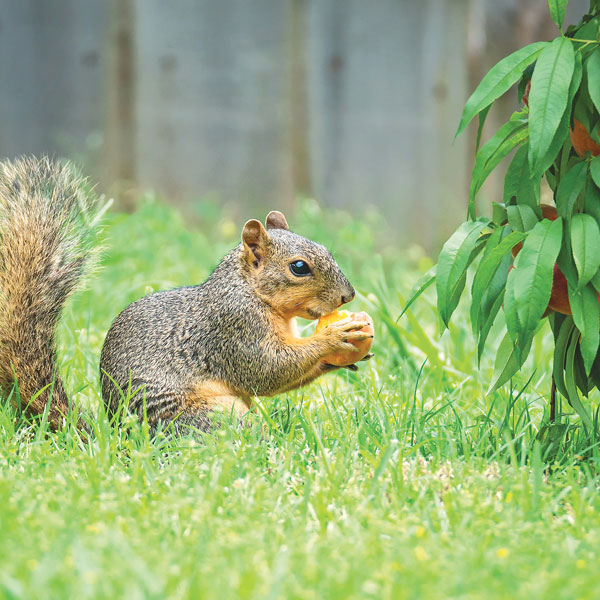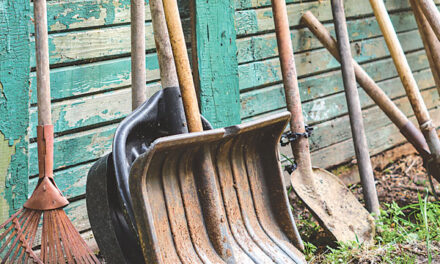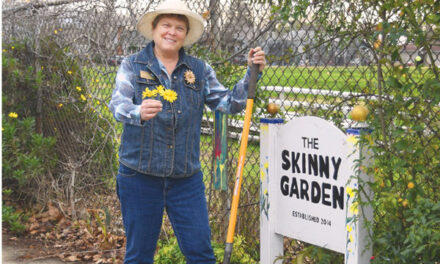Navel oranges, plump, juicy and begging to be plucked, are ripening in Sacramento. Anticipating a morning harvest, it’s not uncommon to discover hollowed-out orange peels clinging to the tree or scattered underneath. The nocturnal spoiler is probably a rat.
Desperate and unhappy home gardeners often pose this question to UC Master Gardeners and nursery folks: “What is eating all my (fill in the blank).” Few urban gardeners are spared the carnage of critters snacking on fruits, nuts and vegetables.
Rats, squirrels and birds are common suspects. We are spared, for the most part, by more voracious garden pests—deer, gophers, moles and rabbits.

Animal garden pests can’t be controlled by insecticides, hand picking or blasts of water. They must be outsmarted.
Rats keep pest-control companies busy. They carry diseases and parasites and can cause tremendous damage by chewing wiring and garden produce. Rats are night creatures, but you may spot a roof rat scurrying across a powerline at dusk.
Rats leave the rinds of oranges. With lemons, they devour rinds and leave the pulp. In warmer seasons, rats eat fruits, nuts, berries and just about anything else.
Rat problems can be reduced by not leaving pet foot outdoors, eliminating or heavily pruning back preferred habitat such as English ivy and jasmine, and cleaning up any piles of “junk” where rats can nest. Traps work best to reduce rat populations. Baits are not recommended.
Last summer, I netted my table grapes to deny the California scrub jays. It worked beautifully until squirrels finished stripping my neighbor’s fig tree and bullied through the netting for a table grape buffet.
Scrub jays have targeted my blueberries for years. Blueberries are easy targets, even with netting. Unlike grapes that are mostly hidden and hang below the main canes and leaf canopy, blueberries can’t hide. Birds easily peck through draped netting unless you attach it to a durable overhead structure.
Changing tactics last spring, I wrapped blueberry bushes in bridal veil material (called tulle) and did not lose a berry! The tighter weave allows light and air to penetrate but not bird beaks.
Tree squirrels are especially problematic, but for every nine people who declare war there’s a neighbor who lovingly feeds squirrels. Smart and persistent, tree squirrels maneuver around most deterrents to dine on home-grown edibles. As a final insult, they dig and bury snacks in pots and beds.
Denying squirrels access to beds and containers is labor intensive but may answer your prayers. Squirrels love bare soil. Areas of bare earth or potting soil can be covered with fist-sized stones or any other space-filling object. Pieces of hardware cloth or chicken wire can be cut and stretched over bare areas and removed when plants grow to fill those spaces.
Fruit and nut trees are much more vulnerable to tree squirrels, who may even chew bark to line nests. Once the outer layer of bark is stripped all the way around a limb, expect it to die. It should be removed.
One recent winter, either squirrels or roof rats chewed a 3-foot-long stretch of bark off a main limb of a lemon tree in my yard. The limb was removed and the tree survived.
Trapping squirrels is not effective because another family will move in. Tree squirrels are classified as game mammals by California Fish and Game Code.
Certain species require a permit for trapping and releasing, and it’s illegal to use poisonous baits on all tree squirrels. Once you have identified the species, check existing laws with the California Department of Fish and Wildlife before taking action.
City of Sacramento animal control doesn’t respond to pest infestations, only to injured wildlife. So you are on your own or you can call a pest-control company. For a deep dive into garden pest control, this site is loaded with information: ipm.ucanr.edu.
Let me know if you have an effective critter-control strategy. Maybe I’ll share it in a future column.
Dan Vierria is a University of California Cooperative Extension Master Gardener for Sacramento County. He can be reached at masterg29@gmail.com. For answers to gardening questions, contact the UCCE Master Gardeners at (916) 876-5338, email mgsacramento@ucanr.edu or visit sacmg.ucanr.edu. Follow us on Facebook, Twitter and Instagram: @insidesacramento.















